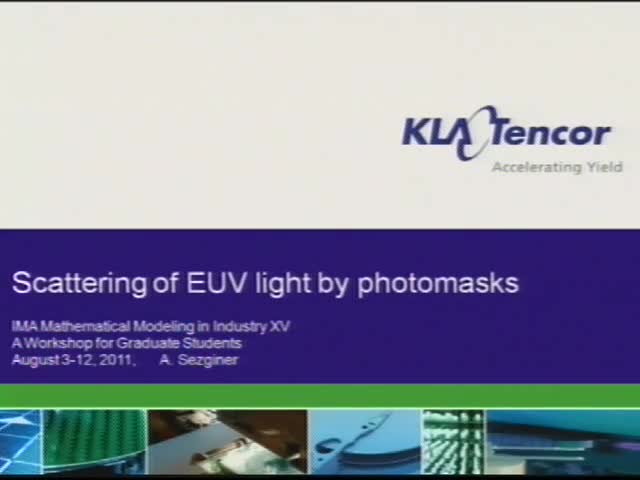Team 4: Diffraction by photomasks
Presenter
August 3, 2011
Keywords:
- Diffraction
MSC:
- 78A45
Abstract
Project Description:
A PC sold in 2010 had billions of transistors with 32 nm gate-length. In a year, that dimension will shrink to 22 nm. Light is essential to fabrication and quality control of such small semiconductor devices.
Integrated circuits are manufactured by repeatedly depositing a film of material and etching a pattern in the deposited film. The pattern is formed by a process called photo lithography. An optical image of a photomask is projected on to a silicon wafer on which the integrated circuits will be formed. Presently, 193 nm wavelength deep UV light is used to project the image. Photomasks are inspected for defects by deep UV microscopy, which is subject to the same resolution limit as lithography. Manufacturing next generation integrated circuits and inspecting their photomasks require higher-resolution imaging. The leading candidate for next generation lithography, EUV (extreme ultraviolet) lithography uses 13.5 nm wavelength. At that wavelength, no material is highly reflective or transparent. The photomask and mirrors of the projector are coated with a multi-layer Bragg reflector to achieve sufficient reflectance. The photomask has a patterned absorber film over the Bragg reflector. The thickness of the absorber and the lateral dimensions of the mask pattern are on the order of four EUV wavelengths.
Rapid yet accurate simulation of EUV image formation is essential to optimizing the photomask pattern and interpreting the images of an inspection microscope. This project concerns the key step of image simulation, which is calculating the diffracted near-field of the EUV photomask.
References:
G. Kirchhoff, Vorlesungen uber Mathematiche Physik, Zweiter Band, Mathematiche Optik, Leipzig, Druck und Verlag, 1891, also books.google.com, p 80 states the Kirchhoff approximation.
H. H. Hopkins, “On the diffraction theory of optical images,” Proc. Roy. SOC. London, Ser. A 217, pp. 408-432, 1953.
C. A. Mack, Inside PROLITH: A Comprehensive Guide to Optical Lithography Simulation, FINLE Technologies (Austin, TX: 1997).
K. Adam, A. R. Neureuther, “Domain decomposition methods for the rapid electromagnetic simulation of photomask scattering,” Journal of Micro/Nanolithography, MEMS, and MOEMS, Vol. 1, No. 3, p. 253-269, 2002, SPIE, Bellingham, WA.
P. Evanschitzky, F. Shao, A. Erdmann, “Simulation of larger mask areas using the waveguide method with fast decomposition technique”, Proc. SPIE Vol. 6730, 2007, SPIE, Bellingham, WA.
Keywords:
Diffraction, Computational Lithography, Partial Coherence Imaging
Prerequisites:
Basic optics, electromagnetics, computational methods for wave equations
